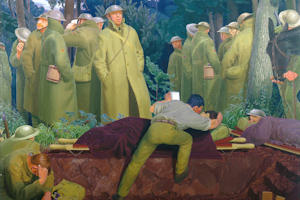Art exploring the impact of war on the human senses goes on show
10 Oct 2014
Manchester Art Gallery will present The Sensory War 1914-2014, a major group exhibition marking the Centenary of the First World War that will explore how artists have communicated the impact of military conflict on the body, mind, environment and human senses between 1914 and 2014

The exhibition, which was co-curated by historian Dr Ana Carden-Coyne from the University, examines how artists from 1914 onwards depicted the devastating impact of new military technologies utilised in a century of conflict beginning with the First World War.
The show will bring together a range of leading artists including Henry Lamb, CRW Nevinson, Paul Nash, Otto Dix, Nancy Spero, Richard Mosse, Omer Fast and will also feature works by the hibakusha; survivors of the atomic bomb dropped on Hiroshima which were created in the 1970s and are being shown in the UK for the first time. Presented across two floors at Manchester Art Gallery, The Sensory War will be one of the most ambitious shows to be staged at the gallery to date.
The First World War involved a profound re-configuration of sensory experience and perception through the invention of devastating military technologies, which destroyed human lives and altered the environment beyond recognition. Its legacy has continued and evolved through even more radical forms of destruction over the last hundred years. Throughout the century, artists have struggled to understand the true effect of modern technological warfare. While military and press photography have brought a new capacity to coldly document such lethal displays, artists found a different way of seeing.
Manchester Art Gallery has a nationally important collection of art of the First World War, which was assembled by its first director, Lawrence Haward. Taking their rich collection as the starting point, this show will comprise both historic and contemporary art from the UK, Germany, France, Italy, the Netherlands, the United States, Canada, Japan, Vietnam, New Zealand, Algeria, Ireland, Iran, Israel and Palestine.
The Sensory War will explore the responses of a range of artists over the past century to the sensory effects of warfare through a series of themes. Militarising Bodies, Manufacturing War will explore artist’s reactions to the industrialised process of militarisation and the effect of noise in the urban environment. It will include work by artists such as CRW Nevinson who depicted scenes from the First World War using the aggressive, Modern visual style of Vorticism. Pain and Succour will explore how artists responded to the treatment of soldiers on the front line and will include Henry Lamb’s ‘Advance Dressing Station on the Struma’ from Manchester Art Gallery’s collection exhibited with Henry Tonk’s ‘An Advanced Dressing Station in France’ from the Imperial War Museum for the first time. Rupture and Rehabilitation will look at how art was employed not only to record the treatment of soldiers in hospitals but also how it reflected on the new medical advances of plastic surgery and facial reconstruction.
Exploring this theme, the exhibition will present all 12 plates of Cologne New Objectivist, Heinrich Hoerle’s ‘Die Krüppelmappe’ (The Cripple Portfolio) alongside his oil painting ‘Three Invalids’. Seen together in the UK for the first time, these works record Hoerle’s tender but also bitter reflections on the ruined bodies of war from a German perspective. Also in this section will be a series of delicate drawings of disabled soldiers recovering in hospital by French female artist Rosine Cahen. Shocking the Senses will look at the experience of shell shock and will include works such as Pietro Morando’s Goyaesque studies depicting the appalling tortures that took place inside prisoner of war camps during the First World War.
Key themes for the exhibition will also include Bombing, Burning and Distant War exploring the effects on the ground of military conflict. As part of this section Omer Fast’s video work ‘5,000 feet is the Best’ will be on show which explores the terror of drone strikes for the victims and the psychological impact on soldiers in recent conflicts of piloting drones from a distant location on another continent. The Embodied Ruin: Natural and Material Environments will look at how artists such as Paul Nash and William Orpen used landscapes destroyed by conflict such as Flanders as a metaphor for the fate of the soldiers who fought there. Chemical War and Toxic Imaginations includes work that has been inspired by gas warfare since the First World War. Within this section, Sophie Jodoin’s haunting drawings of faces wearing gas masks will be on show, which depict a distorted human physiognomy. Haunted Ghostlands: Loss, Resilience and Memory will explore the after-effects of military conflict and will present a powerful work by emerging artist Katie Davies entitled ‘The Separation Line’ exploring the aftermath of the war in Afghanistan by documenting the military repatriation funeral processions through British town, Royal Wootton Bassett.
The Sensory War 1914-2014 is presented in partnership with the Whitworth Art Gallery and the Centre for the Cultural History of War at The University of Manchester. It is curated by Dr Ana Carden-Coyne, Co-Director of the Centre for the Cultural History of War at the University of Manchester; David Morris, Head of Collections, Whitworth Art Gallery; and Tim Wilcox, Principal Curator, Exhibitions at Manchester Art Gallery.
Maria Balshaw, Director of the Whitworth Art Gallery, The University of Manchester and Manchester City Galleries said: “The Centenary of the First World War is such a profound event and we are honoured to mark this historic occasion with the exhibition, The Sensory War 1914-2014. Curated in partnership with the Whitworth Art Gallery and the Centre for the Cultural History of War at the University of Manchester, we are pleased that this exhibition will be one of Manchester Art Gallery’s largest survey shows to date and will bring together the diverse artistic responses to war and conflict over the past century.”
